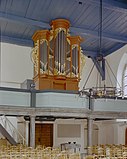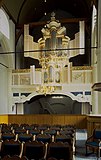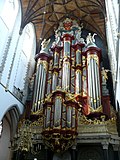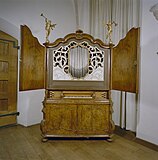Christian Müller (organ builder)
Christian Müller (born February 4, 1690 in Sankt Andreasberg ; ⚰ March 8, 1763 in Amsterdam ) was a German- Dutch organ builder . For the 18th century he is considered the leading organ builder in Holland . His large organ in the St. Bavo Church (Haarlem) achieved international fame .
life and work
Christian Müller was the sixth of seven children of the carpenter Peter Müller (around 1640–1705) and Elisabeth Otte (* around 1652). It is not known where Müller spent his apprenticeship in Germany. In 1716 he moved to Amsterdam and there is evidence that he worked for the Amsterdam organ builder Cornelis Hoornbeeck in 1718. On April 25, 1719, Müller became a member of the Lutheran Church in Amsterdam and went into business a year later. On May 17, 1720, he married Elisabeth van der Berg, who died a year later. Catherina Beverwijk became his second wife on October 19, 1721, who gave him eleven children. She died in Amsterdam on March 3, 1769 and was buried on March 9.
In 's-Hertogenbosch , Müller initially worked as Hoornbeeck's master servant together with Rudolf Garrels at St. John's Cathedral and subsequently received orders for work on three Amsterdam organs, all of which are no longer preserved. His field of work focused on Holland, the west of the country. The monumental organ in St. Bavo in Haarlem, which in its time was one of the largest organs in the world, became world famous. In addition to church organs, Müller also created cabinet organs . In terms of architecture and sound, Müller's organs form a synthesis between the old Dutch organ building of the 17th century and the newer Hamburger-Groninger concept by Arp Schnitger and Albertus Antonius Hinsz .
A relative named Johannes Caspar (* July 23, 1693; † 1746) from St. Andreasberg performed during the Leeuwarder organ building and next to Christian until 1729, but then went into business for himself in The Hague . The son Pieter Müller (* 1738) continued the tradition of his father and created organs in Haarlem (Coen Cuserhuis, 1760, I / 7), Wissenkerke (Prot. Kerk, 1767, I / 7) and Hoorn (Luth. Kerk, 1772 , II / p / 17), which are very similar to those of the father. He was also known as a builder of cabinet organs and harpsichords . The most important student was Johann Bätz , who founded a family of organ builders and continued Müller's work. Other students were Christian Ludwig König and his brother Kaspar Joseph König, Johann Nikolaus Ritter and John Snetzler (1710–1785?), Who worked in England. Müller was buried on March 8, 1763 in the Oude Lutherse Kerk on the Spui .
In 1740 and 1750 Georg Friedrich Handel played the Müller organ in Haarlem and in 1766 ten-year-old Wolfgang Amadeus Mozart . While Klaas Bolt was organist in Haarlem, the instrument was largely restored to its original condition. Improvisation competitions and an international organ festival have been held there since 1951.
List of works (selection)
The following works by Müller have largely been preserved (5th column: large "P" = independent pedal, small "p" = attached pedal):
| year | place | church | image | Manuals | register | Remarks |
|---|---|---|---|---|---|---|
| 1724-1727 | Leeuwarden | Grote of Jacobijnenkerk | III / P | 38 | With Rückpositiv and Echowerk; largely preserved | |
| 1726 | Westerbork | Hervormde Kerk | I / p | 8th | Modification of an older instrument that was originally built for Beetgum ( Friesland ) and transferred in 1862 | |
| 1734 | Amsterdam | Oude Waalse Kerk | II / P | 26th | Largely preserved; Housing from 1680 by Nicolaas Langlez | |
| 1735-1738 | Haarlem | St. Bavo's Church | III / P | 60 | Largely preserved; today III / P / 62 | |
| 1737 | Zaandam | Lutheran Kerk | II / p | 13 | Prospectus and some pipework preserved | |
| 1742 | Bennebroek | Hervormde Kerk | II / p | New building behind the prospectus by Gysbert Bongaert (1686); Internal plant replaced in 1925 | ||
| 1744 | Oosterwijtwerd | Hervormde Kerk | I. | 8th | Cabinet organ; original location unknown | |
| around 1745 | The hague | Grote of St.-Jacobskerk / Van Assendelftkapel | I. | 8th | Cabinet organ; original location unknown | |
| 1747 | Privately owned | I. | 7th | Cabinet organ | ||
| 1756 | Beverwijk | Grote Kerk | II / P | 22nd | Largely preserved | |
| 1762 | Alkmaar | Kapelkerk | II / p | 18th | 1882 changes by L. Ypma |
literature
- Beverwijk Organ Commission (ed.): Jubileumboekje Müller-Orgel 1756–2006. Grote Kerk Beverwijk . Self-published, 2006 ( online [PDF; 2.8 MB ]).
- Klaas Bolt : De historie en samenstelling van het Haarlemse Müller organ . Arti * Novo Publishers, Amsterdam 1985.
- Douglas E. Bush, Richard Kassel (Eds.): The Organ. To Encyclopedia . Routledge, New York, London 2006, ISBN 0-415-94174-1 , pp. 360-361 .
- Gerben Gritter: Christian Müller organ maker in Amsterdam . Amsterdam 2014 ( online [PDF; 6.8 MB ] dissertation).
Web links
- Organ in Haarlem, St. Bavo (English, Dutch)
- Ibo Ortgies : The organ in the Waalse Kerk in Amsterdam
- Organ in Beverwijk, Grote Kerk (Dutch)
Individual evidence
- ^ Gritter: Christian Müller Orgelmaker in Amsterdam. 2014, p. 19 ( online ) (PDF; 6.8 MB).
- ↑ Jubileumboekje Müller organ . 2006, p. 7.
- ^ Gritter: Christian Müller Orgelmaker in Amsterdam. 2014, p. 28 ( online ) (PDF; 6.8 MB).
- ↑ Jubileumboekje Müller organ . 2006, p. 12.
- ↑ Bolt: De historie . 1985, p. 32 f.
- ^ Gritter: Christian Müller Orgelmaker in Amsterdam. 2014, p. 27 ( online ) (PDF; 6.8 MB).
- ^ Organ in Haarlem , accessed on April 4, 2018.
- ^ Organ Festival Haarlem , accessed on April 4, 2018.
| personal data | |
|---|---|
| SURNAME | Müller, Christian |
| BRIEF DESCRIPTION | German-Dutch organ builder |
| DATE OF BIRTH | February 4, 1690 |
| PLACE OF BIRTH | Sankt Andreasberg |
| DATE OF DEATH | buried March 8, 1763 |
| Place of death | Amsterdam |










